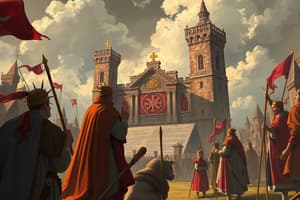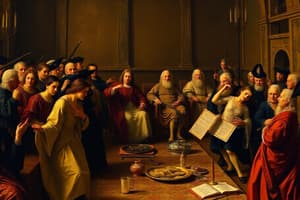Podcast
Questions and Answers
Who played a crucial role in the establishment of the Merovingian Dynasty?
Who played a crucial role in the establishment of the Merovingian Dynasty?
- King Clovis (correct)
- Charles Martel
- The Umayyad Caliphate
- Pepin the Short
What was a significant event in European history related to King Clovis?
What was a significant event in European history related to King Clovis?
- The transformation of power in the Merovingian kingdom
- His conversion to Christianity (correct)
- Establishment of the Carolingian Dynasty
- The Battle of Tours
Who played a significant role in the Battle of Tours against the Umayyad Caliphate?
Who played a significant role in the Battle of Tours against the Umayyad Caliphate?
- The Merovingian Dynasty
- King Clovis
- Pepin the Short
- Charles Martel (correct)
Which ruler solidified the Carolingian Dynasty's rule?
Which ruler solidified the Carolingian Dynasty's rule?
What was the administrative role of the 'Mayors of the Palace' in the Merovingian kingdom?
What was the administrative role of the 'Mayors of the Palace' in the Merovingian kingdom?
Which kingdom emerged during the Early Middle Ages and had geographical boundaries and key rulers?
Which kingdom emerged during the Early Middle Ages and had geographical boundaries and key rulers?
What event in 800 AD solidified the relationship between the Church and the Carolingian Empire?
What event in 800 AD solidified the relationship between the Church and the Carolingian Empire?
Which cultural and intellectual revival during the Middle Ages was marked by the preservation of classical knowledge and the patronage of the arts?
Which cultural and intellectual revival during the Middle Ages was marked by the preservation of classical knowledge and the patronage of the arts?
Which Holy Roman Emperor faced challenges in consolidating and expanding the Holy Roman Empire, including the Investiture Controversy?
Which Holy Roman Emperor faced challenges in consolidating and expanding the Holy Roman Empire, including the Investiture Controversy?
What played a crucial role in preserving and disseminating classical knowledge during the Middle Ages?
What played a crucial role in preserving and disseminating classical knowledge during the Middle Ages?
What led to economic, social, and cultural changes in Western European coastal regions during the Middle Ages?
What led to economic, social, and cultural changes in Western European coastal regions during the Middle Ages?
Which historical event brought significant changes to English society and governance in 1066?
Which historical event brought significant changes to English society and governance in 1066?
What was a central component of feudalism that supported agricultural and craft-based activities?
What was a central component of feudalism that supported agricultural and craft-based activities?
Which event led to the development of common law and the establishment of a unified legal system in England?
Which event led to the development of common law and the establishment of a unified legal system in England?
What drove the growth of towns and cities in medieval Europe?
What drove the growth of towns and cities in medieval Europe?
Where did Charlemagne implement administrative reforms, establishing a centralized bureaucracy?
Where did Charlemagne implement administrative reforms, establishing a centralized bureaucracy?
What was the primary motivation for Viking exploration along Western European coastal regions?
What was the primary motivation for Viking exploration along Western European coastal regions?
In which historical event was Charlemagne crowned as Emperor of the Romans?
In which historical event was Charlemagne crowned as Emperor of the Romans?
Which 13th-century document limited the power of the English monarch and established principles of governance?
Which 13th-century document limited the power of the English monarch and established principles of governance?
What were the three estates represented in the Estates-General during the monarchy in France?
What were the three estates represented in the Estates-General during the monarchy in France?
Which early Slavic civilization adopted Christianity in 988 AD?
Which early Slavic civilization adopted Christianity in 988 AD?
What architectural style was prevalent from the 10th to the 12th centuries and had religious and symbolic significance?
What architectural style was prevalent from the 10th to the 12th centuries and had religious and symbolic significance?
Which intellectual movement aimed to reconcile faith and reason during the Middle Ages?
Which intellectual movement aimed to reconcile faith and reason during the Middle Ages?
Which city emerged as a prominent political and cultural center within the Kievan Rus?
Which city emerged as a prominent political and cultural center within the Kievan Rus?
What was the purpose of the series of military expeditions known as The Crusades?
What was the purpose of the series of military expeditions known as The Crusades?
What was the successor to Romanesque architecture, characterized by pointed arches, ribbed vaults, and flying buttresses?
What was the successor to Romanesque architecture, characterized by pointed arches, ribbed vaults, and flying buttresses?
Which legislative body developed early leading to a representation of the estates of the realm?
Which legislative body developed early leading to a representation of the estates of the realm?
Which Capetian monarch pursued the centralization of power in France?
Which Capetian monarch pursued the centralization of power in France?
Which federation of Slavic tribes adopted Christianity in 988 AD?
Which federation of Slavic tribes adopted Christianity in 988 AD?
What was the long-term impact of The Crusades?
What was the long-term impact of The Crusades?
What was the main purpose of the Inquisition in medieval Christianity?
What was the main purpose of the Inquisition in medieval Christianity?
Which factor contributed to the famines in the Late Middle Ages?
Which factor contributed to the famines in the Late Middle Ages?
What was the devastating impact of the Black Death/Bubonic Plague on European populations?
What was the devastating impact of the Black Death/Bubonic Plague on European populations?
Which parties were involved in the Hundred Years' War?
Which parties were involved in the Hundred Years' War?
What was the role of Joan of Arc in the Hundred Years' War?
What was the role of Joan of Arc in the Hundred Years' War?
What does Reconquista refer to in medieval history?
What does Reconquista refer to in medieval history?
What was the main aim of the Spanish Inquisition?
What was the main aim of the Spanish Inquisition?
What is the significance of patron saints in medieval Christianity?
What is the significance of patron saints in medieval Christianity?
What was the impact of anti-Semitism on medieval Europe?
What was the impact of anti-Semitism on medieval Europe?
What were the long-term effects of the Hundred Years' War on England and France?
What were the long-term effects of the Hundred Years' War on England and France?
Flashcards are hidden until you start studying
Study Notes
- Magna Carta: 13th-century document limiting the power of the English monarch, establishing principles of governance
- Emergence of English Parliament: Early developments leading to a legislative body representing the estates of the realm
- Monarchy in France: Three Estates - Estates-General
- Clergy: religious institution and landowners
- Nobility: hereditary nobles and landed gentry
- Commoners: peasants, artisans, and merchants
- Estates-General: convened during the Hundred Years' War, represented each estate and advised the king on taxes and laws
- Capetian Dynasty/Philip IV: Capetian monarchs ruled France, Philip IV pursued centralization of power
- Kiev: Early Slavic civilization, city established in the 5th century
- Kievan Rus Political Formation: federation of Slavic tribes under a common ruler
- Christianization: Kievan Rus adopted Christianity in 988 AD
- Eastern States of the Slavs: Moscow emerged as a prominent political and cultural center within the Kievan Rus
- Ivan III: Moscow's leadership in the late 15th century, titled "Czar" as a symbol of supreme power
- The Crusades: series of military expeditions for the Holy Land, driven by religious and political motivations
- Long-term consequences: cultural, economic, and technological exchanges, impact on religious communities and the Mediterranean region
- European Culture in the Middle Ages: existing architectural styles and intellectual pursuits
- Romanesque Architecture: prevalent architectural style from the 10th to the 12th centuries, religious and symbolic significance
- Gothic Architecture: successor to Romanesque, characterized by pointed arches, ribbed vaults, and flying buttresses, iconic cathedrals showcasing height and luminosity
- Monastic Schools: centers of learning, monks preserving and illuminating ancient texts
- Theology: study of the divine, integral to medieval thought
- Scholasticism: intellectual movement reconciling faith and reason, prominent scholars like Anselm, Peter Abelard, and Thomas Aquinas
- Vernacular Language & Literature: shift to vernacular languages for literature, emergence of new literary genres, religious orders contributing to society and education, and the Mass as a central religious ritual.
Studying That Suits You
Use AI to generate personalized quizzes and flashcards to suit your learning preferences.




